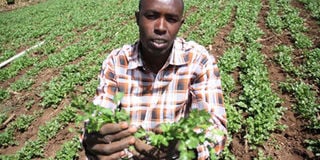I started as a farmhand, now I farm on 30 acres

Bernard Kimani displays some coriander plants that he grows in his farm in Burnt Forest. PHOTO | JARED NYATAYA | NATION MEDIA GROUP
What you need to know:
- To grow the plant, the farmer ploughs the land then farrows before planting directly the seeds into the soil.
- The plants begin to sprout after about two weeks. At this stage, they require plenty of water that he pumps from River Andugulu.
- The challenges come during the rainy season and when there is a dry spell. There are pests that suck saps from the leaves making them become weaker and thinner.
- Farmers should also do crop rotation and field hygiene to control pests and diseases.
Dressed in checkered shirt, a dark brown trouser and gumboots, Bernard Kimani walks between tiny plants in Ruku-ini village in Burnt Forest, Uasin-Gishu County.
The plants are coriander (dhania), which he has grown for about a decade on four acres at any time out of the 30 he farms on, 22 which he has leased for Sh6,000 per acre where he grows maize and wheat.
He owns the other eight.
“I was introduced into farming about 10 years ago by working as a farmhand on peoples’ farms, helping them harvest, weed and plant mostly maize,” says Kimani.
Then, he would earn Sh150 per day, which he saved nearly all of it, helping him lease a tenth-of-an-acre where he planted coriander.
“On the farm, I invested Sh5,000 which went on a 5kg bag of fertiliser, 5kg pack of seeds at Sh1,000 and hired the tenth of an acre at Sh1,000. From this I was able to earn Sh30,000 from my crop after selling the produce to a trader from Kisumu after about a month-and-a-half,” recounts the 38-year-old.
The success made him increase the number of acreage to half-an acre.
To grow the plant, the farmer ploughs the land then farrows before planting directly the seeds into the soil.
The plants begin to sprout after about two weeks. At this stage, they require plenty of water that he pumps from River Andugulu.
CHALLENGES IN THE CROP'S CULTIVATION
He sprays the plants with a herbicide to kill weeds after another two weeks before applying urea or CAN.
“And then after two weeks, I manually weed using the fork jembe before the crop is ready for harvest.”
He sells the produce to traders in Eldoret, Kisumu, Nairobi and even Mombasa. Though he plants throughout the year, he usually expands the number of acreage especially from October to March when there is huge demand in the market.
“The market for coriander is huge but the prices sometimes fall when there is oversupply. When there is scarcity, I sell a 90kg bag for up to Sh6,000 but this drops to a low of Sh500 per bag sometimes,” says the farmer, who earns in a good season over Sh100,000 from the crop.
Those who want to grow the herb used as a spice must be contend with various challenges.
“The challenges come during the rainy season and when there is a dry spell. There are pests that suck saps from the leaves making them become weaker and thinner.”
More money for him comes from selling the crops’ seeds at Sh500 per 2kg tin.
“I only bought the first seeds but now I save my own from the farm because some of the crops produce heads within a month making it difficult to sell them,” Kimani, who dropped out of school in Class Eight for lack of fees, says.
CROP ROTATION, FIELD HYGENE
When he is not harvesting dhania, he is harvesting cabbages, potatoes or maize.
“I normally plant potatoes and returns from them I use to farm maize and the returns from the cereal I use to grow dhania and carrots and maize. From two acres, I get between 70 to 80 90kg bags of maize that I sell for at least Sh2,300,”
Carol Mutua, a horticultural expert at Egerton University, says dhania is prone to some pests.
“Caterpillars eat the leaves of coriander, thus, lowering quality. To control, use Bacillus thuringiensis (Halt), Duduthrin or Thunder,” she says.
She adds that leafhopper, another pest, also feeds on the leaves. But control measures are same as those applied on caterpillars. On the other hand, aphids suck sap from the leaves causing curling. Control include Primor or
Thunder. For thrips, which suck sap leaving silvery patches on the leaves, one should use Ambush, Parathion or Malathion.
“Farmers should also do crop rotation and field hygiene to control pests and diseases.”





